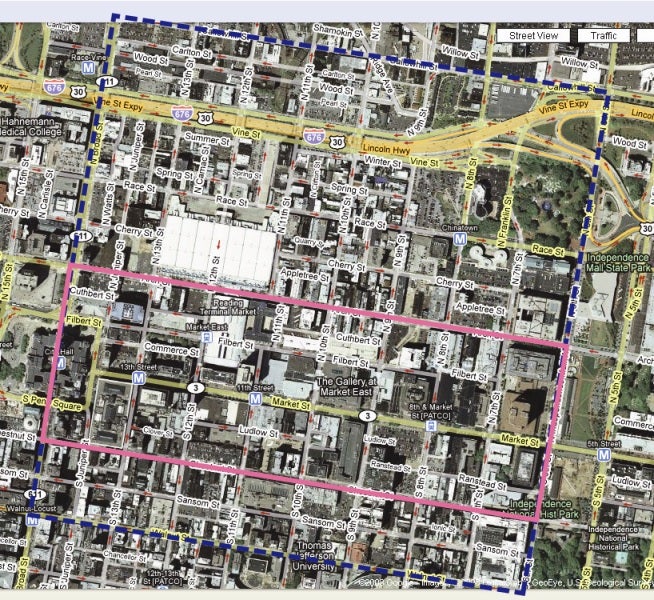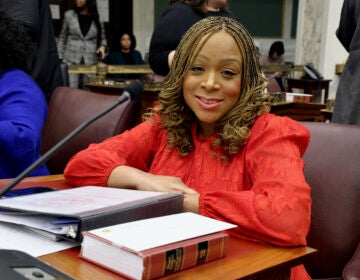Taking a closer look at what the CED means

PCPC impact study area in blue dashes; designated Foxwoods CED in pink
Oct. 22
By Kellie Patrick Gates
For PlanPhilly
The city’s top planners want to make something clear: There is no plan for a casino district in Philadelphia. And the casino-related zoning legislation that the Planning Commission blessed on Tuesday cannot make one happen.
“There’s absolutely no vision here of creating any kind of Las Vegas-like strip on Market East,” said Gary Jastrzab, the Commission’s acting executive director. “That’s probably where the concern lies. That is not the intention.”
The casino-related zoning legislation consists of two bills proposed last week by Councilman Frank DiCicco. One of them would create a new Commercial Entertainment District zoning classification. The other would apply that classification to The Gallery at Market East – the site where Foxwoods Casino may build.
A geographic difference in the language of the two bills got neighborhood activists concerned about the prospect of additional casinos. The bill that creates the new CED has a much larger footprint than the Gallery site.
Planning officials said Tuesday that the footprints differ because the city could not create a new CED that could be applied only to one property – that would be illegal spot zoning. And even if this CED proposal becomes law, they said, there could be no additional casinos without the state granting additional licenses and the City Planning Commission and City Council agreeing to apply the new CED to another applicant’s property.
Wednesday, DiCicco spokesman Brian Abernathy pointed out that the current CED legislation – the one crafted when Foxwoods was focusing on its riverfront site – can already be applied anywhere in the city.
Councilman DiCicco’s proposal specifies a swath of city blocks to which the older CED classification would not be applied, Abernathy said. If the new CED passes City Council, an applicant who wanted to build a casino within that swath – 6th to Broad, Chestnut to Arch – would have to meet the requirements of the new proposal. If it fails, he said, the applicant could still apply for a CED, but they would have to meet the terms of the existing classification.
DiCicco and city planners looked at the characteristics of The Gallery site and the blocks around it within DiCicco’s district and saw that the old CED did not work in this denser, more typically urban area, Abernathy said.
Jastrzab said, “it would be nearly impossible to use the old CED to build a casino in Center City.”
And if the amended version passes for the area between 6th and Broad, Chestnut and Arch, it would be much easier for a developer to build within that area than elsewhere in Center City, Jastrzab and William Kramer, the Commission’s division director of development and planning, agreed.
Kramer gave some examples: While the old CED assumes a structure would be built from the ground up, the new proposal would make it easier to use an existing structure. The old one requires parking on site. In Center City, that would likely mean building a deep underground lot, Kramer said. But the new CED allows the parking requirement to be met by off-site, existing parking.
To meet the existing standard in a dense business district would require “legislative relief” from the city, Kramer said. “Rather than put them through that, we have a CED proposed in this area where, boom, they can take advantage of existing infrastructure,” he said.
Referencing the fact that some residents don’t want casinos anywhere in the city, Jastrzab said that thanks to the State Legislature, “We’re going to get those two whether we like it or not.”
DiCicco has spoken at length at recent community meetings in Chinatown and Washington Square West about a change in his tactics. When Foxwoods was at the waterfront, he said, he stood with the protestors and didn’t engage. That landed the City in State Supreme Court, where the Court eventually told the City they had to map the old CED to the waterfront locations. That cut the city and its oversight out of the process, he said, so this time, he’s being proactive.
“What is the worry?” Abernathy asked. “There is still additional legislation that would have to be passed for a new casino to be built. Any additional casino would go through a strong vetting process.”
But what DiCicco sees as proactive, some activists see as giving in to the casinos. And some are very worried about the proposed CED for Market East.
Before Tuesday’s Planning Commission meeting, Society Hill Civic Association board member Rosanne Loesch was focused on keeping one casino from Market East. Now, she’s concerned that the City is poised to make it easier for more casinos to locate within the entire corridor.
The reminders given by officials that the state would have to add more licenses and that the Planning Commission and City Council would have to approve the plans and permits did not appease her – she’s not certain that those things would be hard to come by. And neither does the knowledge that the old CED would still apply to Market East if the new one doesn’t pass.
A casino would have been hard pressed to meet the standards of the old CED along the Market East corridor, she said. “Now we’ve said, ‘well, this is how you do it. We’ve provided for you something that works with this densely populated Center City area. It’s a roadmap, an absolute roadmap.”
Paul Boni, attorney for the anti-casino group Casino-Free Philadelphia, said it would be better for a city that wants to limit casinos to leave the current CED in place and require any applicants to get some sort of zoning variance.
Abernathy said he thinks some of the critics are “fear mongering” for their own purposes.
The community activists’ concerns are genuine, Boni said. “All we did was react to what Altman said,” during the meeting, he wrote in an email. “We are not fear mongering. HE scared US.”
DiCicco and city planners came up with the footprint for the new CED by looking at the characteristics of The Gallery site and the blocks around it within DiCicco’s district, Abernathy said. In addition to the differences Kramer mentioned, Abernathy explained several weeks ago that the old setback requirements are too big for typical urban blocks where the goal is to have buildings meet the sidewalk. And too many additional parking spaces are required for an area that is well-served by mass transit and existing parking garages. The existing CED was also created for places that have larger land parcels, Jastrzab said.
There are sections of the city outside DiCicco’s district that are similarly dense. City Council has a tradition of Councilmatic Privilege – simply put, council members tend to only propose legislation that impacts their own district.
Jastrzab, of the Planning Commission, elaborated on the spot zoning issue Wednesday. He said that spot zoning can land a city in court because changing the zoning of a single parcel can take away property rights or strongly increase or decrease the monetary value of that parcel. “We have to be really careful,” he said, noting the city’s 0-14 record on casino-related issues in State Supreme Court.
In addition to avoiding that risk, putting the entire Market Street East business corridor under the same zoning conditions makes sense from a planning point of view, Jastrzab said.
“The way an area is zoned should be based upon a plan for the area,” he said. City planners and elected officials are careful to say that the proposed Foxwoods relocation to Market East may not happen, because a plan has not yet been proposed, let alone evaluated, and City Council could say no.
But many, including Mayor Michael Nutter and Deputy Mayor for planning Andy Altman have said that if Foxwoods does wind up at The Gallery, it should be the basis for a broader re-visioning and revitalization of the entire corridor. And it is that corridor, Jastrzab said, that is defined in the new CED legislation.
“In doing a new master plan for this area, it’s a logical unit of geography,” he said. “It’s a unit of geography that just makes sense for this kind of intense commercial use.”
The studies that city planners are doing for that new master plan are actually looking at a somewhat broader area – 6th to Broad and Walnut to Callowhill.
The CED does allow for uses other than a casino, including hotels, restaurants, exhibition halls, night clubs and theaters. These were included because officials anticipate any casino might one day have a second phase of development, which might include some of these things. Some portions of the Gallery were designed to hold additional stories.
In theory, a developer who does not have a casino could apply for CED designation for one of these uses, Jastrzab said, but that wouldn’t make sense. The entire Market East CED area is zoned C-5, he said. That’s the city’s most intense and dense commercial zoning classification, and it already allows for the non-casino uses the CED would allow, without requiring all of the analysis that the CED designation requires.
Contact the reporter at kelliespatrick@gmail.com
WHYY is your source for fact-based, in-depth journalism and information. As a nonprofit organization, we rely on financial support from readers like you. Please give today.





